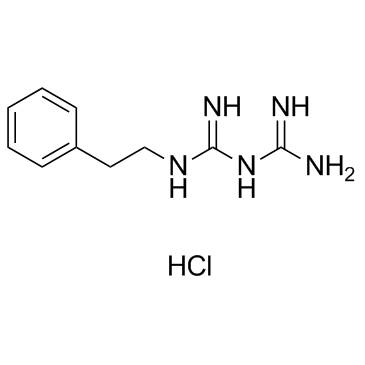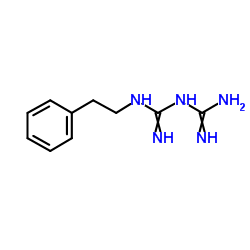834-28-6
| Name | Phenformin hydrochloride |
|---|---|
| Synonyms |
Phenformin hydrochloride
Phenformini Hydrochloride Insora meltrol phenforminhclno.9113 Imidodicarbonimidic diamide, N-(2-phenylethyl)-, hydrochloride (1:1) Glucopostin Phenformine HCL dbi-td β-PEBG HCl DBI monohydrochloride usafvi-6 MFCD00035039 Phenformin HCl PhenforMin HCl API UNII-91XC93EU03 EINECS 212-637-3 Insoral N-(2-Phenylethyl)imidodicarbonimidic diamide hydrochloride (1:1) N-Phenethylbiguanide hydrochloride 1-(2-Phenylethyl)biguanide hydrochloride N'-b-Phenethylformamidinyliminourea Hydrochloride Phenformin (hydrochloride) 1,1-Benzylmethylbiguanide hydrochloride |
| Description | Phenformin (hydrochloride) is a hydrochloride salt of phenformin that is an anti-diabetic drug from the biguanide class, can activate AMPK activity. |
|---|---|
| Related Catalog | |
| Target |
AMPK |
| In Vitro | Phenformin stimulates the phosphorylation and activation of AMPKalpha1 and AMPKalpha2 without altering LKB1 activity[1]. Phenformin increases AMPK activity and phosphorylation in the isolated heart, the increase in AMPK activity is always preceded by and correlated with increased cytosolic [AMP][2]. Phenformin is a 50-fold more potent inhibitor of mitochondrial complex I than metformin. Phenformin robustly induces apoptosis in LKB1 deficient NSCLC cell lines. Phenformin at 2 mM similarly induces AMPK signaling as shown by increased P-AMPK and P-Raptor levels. Phenformin induces higher levels of cellular stress, triggering induction of P-Ser51 eIF2α and its downstream target CHOP, and markers of apoptosis at later times. Phenformin induces a significant increase in survival and therapeutic response in KLluc mice following long-term treatment[3]. Phenformin and AICAR increases AMPK activity in H441 cells in a dose-dependent fashion, stimulating the kinase maximally at 5-10 mm and 2 mm, respectively. Phenformin significantly decreases basal ion transport (measured as short circuit current) across H441 monolayers by approximately 50% compared with that of controls. Phenformin and AICAR significantly reduce amiloride-sensitive transepithelial Na+ transport compared with controls. Phenformin and AICAR suppress amiloride-sensitive Na+ transport across H441 cells via a pathway that includes activation of AMPK and inhibition of both apical Na+ entry through ENaC and basolateral Na+ extrusion via the Na+,K+-ATPase[4]. Phenformin-treated rats reveals a tendency towards a decrease in blood insulin level (radioimmunoassay)[5]. |
| In Vivo | Phenformin increases levels of P-eIF2α and its target BiP/Grp78 in normal lung as well as in lung tumors of mice[3]. |
| Kinase Assay | Total AMPK activity is measured using the method of Dagher et al. AMPK activity is quantified in the resuspended pellet as incorporation of 32P from [γ-32P]ATP (10 GBq/mmol) into a synthetic peptide with the specific target sequence for AMPK, the SAMS peptide. Radioactivity is measured using a liquid scintillation counter. Protein content in the solution containing the resupended (NH4)2SO4 pellet is determined using the Bradford method. |
| References |
| Density | 1.24 g/cm3 |
|---|---|
| Boiling Point | 413.7ºC at 760 mmHg |
| Melting Point | 175-178ºC |
| Molecular Formula | C10H16ClN5 |
| Molecular Weight | 241.721 |
| Flash Point | 204ºC |
| Exact Mass | 241.109421 |
| PSA | 97.78000 |
| LogP | 2.72010 |
| Storage condition | -20°C Freezer |
| Water Solubility | >=10 g/100 mL at 21 ºC |
CHEMICAL IDENTIFICATION
HEALTH HAZARD DATAACUTE TOXICITY DATA
MUTATION DATA
|
| Symbol |

GHS07 |
|---|---|
| Signal Word | Warning |
| Hazard Statements | H302 |
| Personal Protective Equipment | dust mask type N95 (US);Eyeshields;Gloves |
| Hazard Codes | Xn:Harmful |
| Risk Phrases | R22 |
| Safety Phrases | S36 |
| RIDADR | 2811.0 |
| WGK Germany | 3 |
| RTECS | DU2200000 |
| Hazard Class | 6.1 |
| HS Code | 2942000000 |
| Precursor 0 | |
|---|---|
| DownStream 1 | |
| HS Code | 2942000000 |
|---|



